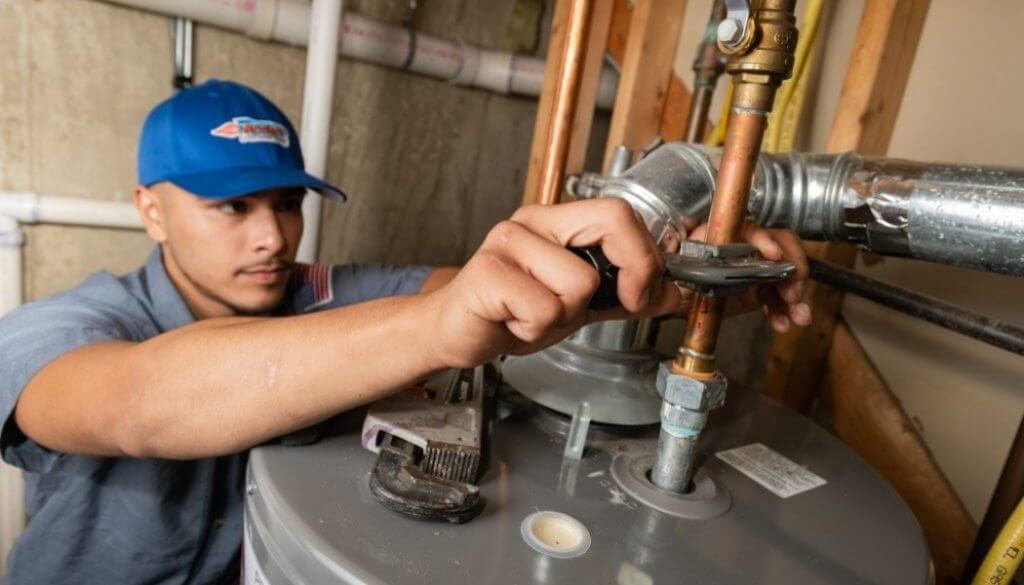Understanding Water Heater Maintenance & Replacement
Water heaters are silent champions of our homes. They ensure that every cold morning turns warm and every dirty dish sparkles clean. However, there comes a time in every water heater’s life when it needs maintenance or a complete replacement. And when that time arrives, the intricate maze of parts and decisions can be daunting. Discover the benefits of a water heater check up and learn when it’s time to replace your old unit.

The Lifespan of a Water Heater
Most traditional tank water heaters have a lifespan of about 8-12 years. But like any other appliance, wear and tear, coupled with neglect, can reduce that lifespan. Telltale signs like lukewarm water, rust forming around the bottom of the tank, or the pilot light going out indicate it’s probably time for a check-up or a replacement. And while some brave souls may consider venturing into the realm of DIY, it’s essential to remember: your water heater is not just a simple appliance; it’s a complex system. Make a water heater check up part of your home routine to keep small problems from growing into an overwhelming issue.
Traditional vs. Tankless: What’s the Difference?
Before we dive deeper on the importance of a regular water heater check up, let’s decipher the difference between traditional and tankless water heaters. Conventional water heaters store and preheat 30-50 gallons of water in a tank. This water is used whenever someone showers, does the laundry, or washes dishes. And, as you probably have experienced, if many people use the hot water you can eventually run out. You then have to wait until the tank can heat itself up again.
On the other hand, as the name suggests, tankless water heaters heat the water directly without needing a storage tank. They provide hot water only as necessary, making them more energy-efficient in the long run. But they also can provide endless hot water since there is no storage tank being used.
The Allure of Going Tankless
Besides traditional water heaters, many homeowners are now leaning towards tankless versions. Here’s why:
- Energy Efficiency: They only heat water on demand, meaning they’re not continuously using energy to keep a water tank heated.
- Endless Hot Water: Since there isn’t a tank being used to heat the water, you can have an endless supply of hot water.
- Space Savers: Given that they don’t require a bulky tank, they’re perfect for homes or ADUs with limited space.
Common Reasons for Water Heater Replacement
Water heaters are robust appliances but can succumb to wear and tear over time, especially if you haven’t kept up with a regularly-scheduled water heater check up. Here are some common reasons why people need to replace their water heaters:
Age is a primary factor; most tank heaters last 8-12 years before efficiency drops.
Rust and corrosion inside the tank or at the inlet valve can lead to discolored water and leaks.
Speaking of leaks, a leaky tank can quickly escalate from a minor issue to a major one, necessitating immediate replacement.
Inconsistent heating, where the water is either too hot or never warm enough, is another sign.
A sediment buildup at the tank’s base can cause popping or rumbling noises and reduce heating efficiency.
Lastly, if you notice higher utility bills without a notable increase in usage, your water heater’s declining efficiency might prompt a replacement.
Maintenance Tips for Tank Water Heaters
Since tank water heaters have been in people’s homes since the 1900s, they are most commonly found. There are a few items to inspect on your water heater to head off problems before they become critical.

- Water Heater Flush: Inspect your water heater’s tank, especially around the bottom, for flaking paint or visible rust spots. Twice a year, you should open the valve on the tank to rinse away any sediment buildup. Not only does sediment make the tank less efficient, but the corrosion can cause the tank to burst.
Pro Tip: When a plumber installs your new water heater, have them replace the drain valve with a ball valve to make flushes easier.
- Shut-Off Valves: If your water heater has gate valves (the type with the round handle), you can turn them off and then on again to keep the internal valve components from seizing.
Pro Tip: If your system has gate valves, ask a plumber to swap them out with ball valves. This would be the same for the gas lines also.
- Anode Rod: One of the major reasons why plumbing components wear out quickly is due to water quality. Garbage in, garbage out. The anode rod attracts harmful elements in your water through electrolysis instead of the particles attacking the tank.
Pro Tip: You can choose different anode rods based on the elements in your water. Ask your plumber how.
- Water Heater Venting: Since water heaters are relegated to tiny spaces in your home, sometimes they can get dented, the pieces can come loose, or the venting cannot be as efficient. If you’re unsure, call a plumber.
- Gas Leaks: Gas lines should always be installed with a paste thread sealant so it fills the gaps between the threads. If your water heater was installed with tape, an undetected leak may have developed. Call a plumber to test around the gas line fittings for a possible leak.
Pro Tip: Water and fire are not to be messed with, so if you’re unsure, please call a reputable plumber to help set things straight again.
- Faulty Thermostat: Regularly flushing your water heater helps prolong the sensors inside the tank that tell the thermostat to turn on or off.
Pro Tip: Adjusting your water temperature periodically (like when you leave for vacation) is another way to ensure it works properly.
Schedule Your Water Heater Check Up Service Today!
Why Professional Replacement is Crucial
- Safety First: Dealing with gas and water lines and venting isn’t a casual weekend project. It requires specialized knowledge and tools to ensure everything is safely disconnected and connected.
- Correct Parts and Installation: Every water heater model is different. Knowing which parts are compatible, understanding the local building codes, and having the right tools ensure the installation is efficient and safe.
- Save Time and Energy: Instead of spending hours or even days figuring out the installation, why not let a professional handle it? Professionals do this for a living rather than replacing a water heater once every 10-15 years. They do it routinely—no need for YouTube videos or online guides. Plus, you’ll have peace of mind knowing it’s done correctly and efficiently.

The Step-by-Step Guide to Water Heater Replacement
Water heater replacements, while not an impossible DIY project, definitely require having the proper knowledge or professionals by your side. Depending on your set-up, model, and experience, this can be a straightforward task or an all-day affair. In general, here’s a step-by-step walk-through for a typical water heating system:
- Safety Precautions First
Before starting any replacement, it’s crucial to turn off the power. For electric heaters, switch off the circuit breaker. For gas heaters, turn the thermostat to the “off” setting.
- Turn Off the Water and Gas Supply
You can do this by turning off both the cold and hot water valves situated atop the water heater. The water supply is sometimes indicated by a blue handle. Then, turn the gas valve off.
- Drain the Water Tank
Connect a garden hose to the drain valve located near the bottom of the water heater. Ensure the other end is in a location (like a drain or outside) where hot water can safely flow out. Open the drain valve and allow the tank to empty.
- Disconnecting the Old Heater
For gas heaters: Disconnect the gas line using two pipe wrenches (one to grip and one to turn). Additionally, disconnect the vent pipe from the unit.
For electric heaters: Remove the electric wires from the heater’s junction box and ensure they’re safely capped.
- Install the New Water Heater
Place your new unit in the desired location, making sure it’s level. If necessary, use shims. Ensure a minimum clearance space is around it per the manufacturer’s instructions or local building codes.
- Reconnect the Water Lines
Connect the cold water line to the cold inlet and the hot water line to the hot outlet. (NOTE: Always replace your hoses when Installing a new water heater.) You might also need to solder solid copper pipe for a stronger connection or due to building codes.
- Reconnect Gas or Electric Lines
For gas heaters: Apply plumbing sealant paste on the threads and connect the gas supply line. Ensure to test for leaks using a gas leak detector.
For electric heaters: Reconnect the wires to the junction box in the unit, ensuring the right connections.
- Fill Up the Tank
Turn on the cold water supply and let the tank fill up.
- Power or Gas On
For electric heaters, turn the power back on. For gas heaters, turn the gas supply on and ignite the pilot, following the manufacturer’s instructions.
- Check for Leaks
After a few hours, inspect the base and connections for any signs of water leaks. Address any leaks immediately.
- Set the Temperature
A temperature setting of 120°F is usually optimal for most homes. Adjust according to your preference but ensure it’s safe for use.
Water heater replacement might look simple on paper, but it requires finesse and expertise.
If, at any point, things seem overwhelming or you need more clarity about a step, it’s best to consult with a professional.
Rocket Plumbing: Your Go-To Experts
Our step-by-step guide makes the water heater installation process seem like a breeze. But why take a gamble with something so essential?
Rocket Plumbing doesn’t just offer plumbing services; we provide peace of mind. Our team is trained in handling both tank and tankless water heaters. We ensure:
- Top-notch Quality: Our services are unmatched in terms of quality and precision.
- Quick Turnaround: We value your time. With Rocket Plumbing, you’re not just getting a service; you’re investing in efficiency.
- Friendly but Professional: Our team combines the warmth of understanding your needs with the professionalism of executing the task flawlessly.
So, before you consider diving into the world of DIY water heater check up and installations, ask yourself: isn’t your home’s comfort, safety, and efficiency worth calling in the experts? Ready to install your new water heater? Contact Rocket Plumbing now, and let us handle the heavy lifting while you sit back and enjoy the endless flow of water heated to your liking!

